Related Research Articles
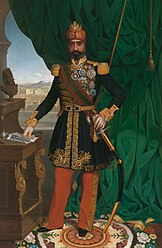
Muhammad III as-Sadiq GCB was the Husainid Bey of Tunis from 1859 until his death. Invested as Bey al-Mahalla on 10 June 1855, he succeeded his brother Muhammad II ibn al-Husayn on 23 September 1859. Named as divisional General in the Imperial Ottoman Army on 10 June 1855, he was promoted to the rank of Marshal on 10 December 1859.

Muhammad VI al-Habib, commonly known as Habib Bey was the sixteenth Husainid Bey of Tunis, reigning from 10 July 1922 until 11 February 1929.

Muhammad VIII al-Amin known as Lamine Bey, was the last Bey of Tunis, and also the only King of Tunisia.

Ali Bey was the Husainid Bey of Tunis from 1882 until his death. He was the first ruler under the French protectorate.
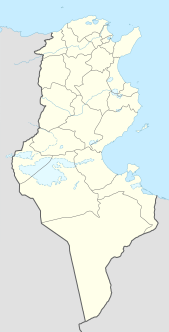
Béja is a city in Tunisia. It is the capital of the Béja Governorate. It is located 105 kilometers (65 mi) from Tunis, between the Medjerdah River and the Mediterranean, against the foothills of the Khroumire, the town of Béja is situated on the sides of Djebel Acheb, facing the greening meadows, its white terraces and red roofs dominated by the imposing ruins of the old Roman fortress.

The process of Tunisian Independence occurred from 1952 to 1956 between France and a separatist movement led by Habib Bourguiba. Bourguiba became the first Prime Minister of the Kingdom of Tunisia after negotiations with France successfully brought an end to the colonial protectorate leading to independence.

Ahmed I, born 2 December 1805 in Tunis died May 1855 at La Goulette, was the tenth Husainid Bey of Tunis, ruling from 1837 until his death. He was responsible for the abolition of slavery in Tunisia in 1846.

Mohammed Bey or M'hamed Bey, was the eleventh Husainid Bey of Tunis, ruling from 1855 until his death. He was the son of Al-Husayn II ibn Mahmud and his second wife Lalla Fatima al-Munastiri.
Mahmoud Djellouli (1755–1839) was a trader and Tunisian diplomat. He was a member of the same clan as Saheb Ettabaâ and among the important figures of his time.

The Medina of Tunis is the medina quarter of Tunis, the capital of Tunisia. It has been a UNESCO World Heritage Site since 1979.
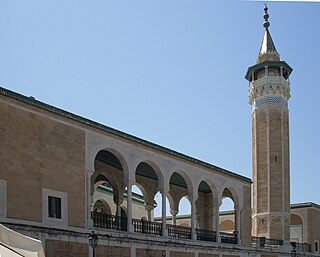
Saheb Ettabaâ Mosque, also known as Youssef Saheb Al Tabaa Mosque, is a mosque in Tunis, Tunisia, located in the Halfaouine area of the city. It is an official Historical Monument. It is the last great mosque built in Tunis before the establishment of French protectorate in 1881.
Hammuda Pasha Bey, died 1666 was the second Bey of the Tunisian Muradid dynasty. He reigned from 1631 until his death.
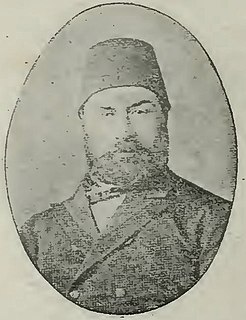
Hayreddin Pasha was an Ottoman-Tunisian statesman and reformer, who was born to a Circassian family. First serving as Beylerbeyi of Ottoman Tunisia, he later achieved the high post of Grand Vizier of the Ottoman Empire. He was a political reformer during a period of growing European ascendancy. He was a pragmatic activist who reacted against poor conditions in Muslim states, and looked to Europe for solutions. He applied the Islamic concept of "maṣlaḥah", to economic issues. He emphasized the central role of justice and security in economic development. He was a major advocate of "tanẓīmāt" for Tunisia's political and economic systems.
Mohammed Khaznadar, born around 1810 on the island of Kos and died on 1889 at La Marsa was a Tunisian politician.
Abu Muhammad Rashid al-Shakir Sahib al-Taba'a, born around 1790 and died 11 September 1837 at Le Bardo, was a Tunisian politician of Circassian origin.
Mourad II Bey, died 1675 in the palace of Bardo was the third Muradid Bey of Tunis from 1666 until his death.
Ibrahim Sharif was Bey of Tunis from 1702 to 1705, during the period of crisis which brought an end to the Muradid dynasty and preceded the rise to power of Husayn I Bey.

Dar Hammuda Pasha is an old palace in the medina of Tunis. It is considered as one of the oldest and biggest palaces of the medina that kept their original architecture.
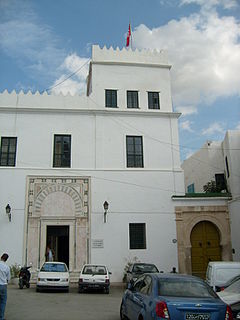
Dar Hussein, is an old palace in the medina of Tunis.
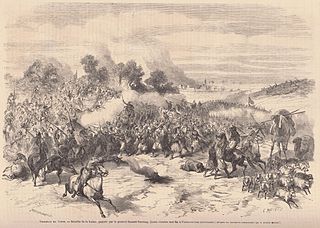
The Mejba Revolt (1864–65) was a rebellion in Tunisia against the doubling of an unpopular poll tax imposed on his subjects by Sadok Bey. The most extensive revolt against the rule of the Husainid Beys of Tunis, it saw uprisings all over the country and came close to prompting military intervention by Britain and France. The revolt was suppressed with great brutality and the government became ever more seriously indebted to foreign creditors, backed by European governments, until it was finally unable to resist French occupation in 1881.
References
- ↑ Mahmoud Bouali (1976). Le temps de la non-révolte, 1827-1832. S.T.D. p. 582. Retrieved 8 April 2021.
- ↑ Azzedine Guellouz (1983). Les temps modernes. Société tunisienne de diffusion. p. 248. Retrieved 8 April 2021.